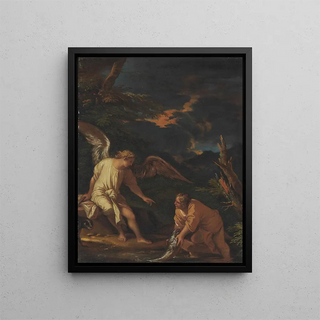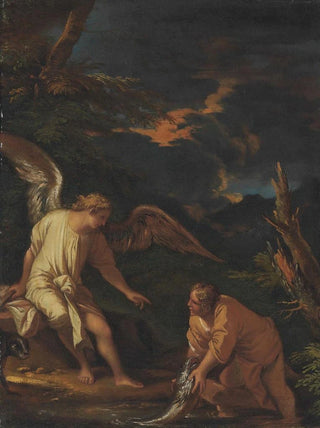Art print | Tobias and the Angel - Salvator Rosa Source: Reproduction | Tobias et l'ange - Salvator Rosa


View from behind

Frame (optional)
In the fascinating world of art history, certain artworks stand out for their ability to capture the essence of biblical stories while revealing the psychological depth of their characters. "Tobias and the Angel" by Salvator Rosa is one of those iconic pieces that transports the viewer to the heart of a spiritual and human adventure. This painting, illustrating Tobias's initiatory journey accompanied by the angel Raphael, evokes universal themes such as faith, divine protection, and the quest for identity. The scene, rich in emotion, invites attentive contemplation, allowing exploration of the subtleties of the relationship between man and the divine.
Style and uniqueness of the work
Salvator Rosa's style is characterized by a harmonious blend of realism and dramatization. In "Tobias and the Angel," the composition is carefully orchestrated, with each element contributing to the visual storytelling. The figures are rendered with remarkable expressiveness, while the landscape in the background, with its majestic mountains and cloudy skies, creates an atmosphere that is both mystical and tangible. Rosa uses a palette of earthy colors, accentuated by luminous touches, to reinforce the contrast between divine light and the shadow of human uncertainty. This chromatic choice, combined with a fluid brush technique, gives the artwork a dynamic quality that captures the eye and the mind, making each glance at the painting unique and revealing new interpretations.
The artist and his influence
Salvator Rosa, an emblematic figure of the 17th century, is recognized not only for his painting talents but also for his ability to fuse art and literature. Influenced by Baroque currents, he created a style that is uniquely his own, blending poetic forms with deep philosophical reflection. Rosa often explored mythological and religious themes, seeking to transcend simple storytelling to offer a rich aesthetic experience full of meanings. His impact on his contemporaries and subsequent generations is undeniable, inspiring artists across Europe to adopt a more narrative and expressive approach in their works. The way he captured human emotions and spiritual relationships opened

Matte finish

View from behind

Frame (optional)
In the fascinating world of art history, certain artworks stand out for their ability to capture the essence of biblical stories while revealing the psychological depth of their characters. "Tobias and the Angel" by Salvator Rosa is one of those iconic pieces that transports the viewer to the heart of a spiritual and human adventure. This painting, illustrating Tobias's initiatory journey accompanied by the angel Raphael, evokes universal themes such as faith, divine protection, and the quest for identity. The scene, rich in emotion, invites attentive contemplation, allowing exploration of the subtleties of the relationship between man and the divine.
Style and uniqueness of the work
Salvator Rosa's style is characterized by a harmonious blend of realism and dramatization. In "Tobias and the Angel," the composition is carefully orchestrated, with each element contributing to the visual storytelling. The figures are rendered with remarkable expressiveness, while the landscape in the background, with its majestic mountains and cloudy skies, creates an atmosphere that is both mystical and tangible. Rosa uses a palette of earthy colors, accentuated by luminous touches, to reinforce the contrast between divine light and the shadow of human uncertainty. This chromatic choice, combined with a fluid brush technique, gives the artwork a dynamic quality that captures the eye and the mind, making each glance at the painting unique and revealing new interpretations.
The artist and his influence
Salvator Rosa, an emblematic figure of the 17th century, is recognized not only for his painting talents but also for his ability to fuse art and literature. Influenced by Baroque currents, he created a style that is uniquely his own, blending poetic forms with deep philosophical reflection. Rosa often explored mythological and religious themes, seeking to transcend simple storytelling to offer a rich aesthetic experience full of meanings. His impact on his contemporaries and subsequent generations is undeniable, inspiring artists across Europe to adopt a more narrative and expressive approach in their works. The way he captured human emotions and spiritual relationships opened






